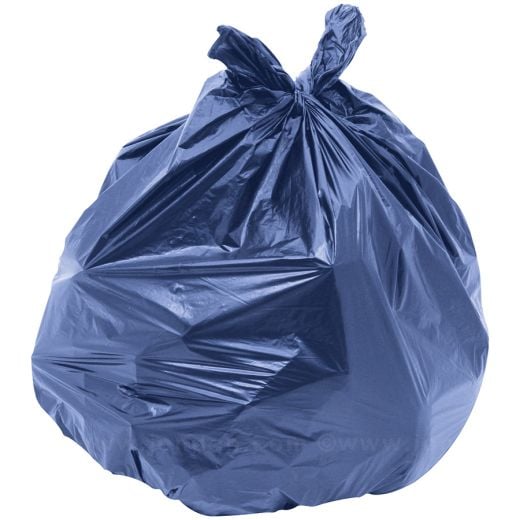Unitex® Trash Liners, Low Density, Heavy Duty, 55 Gallons, 45" x 51", 1.2 mil, Blue (100 PK)
All sales final - returns not accepted. Read more
Product Highlights
- Ideal for carrying large loads with sharp objects
- Star seal provides extra capacity
- Provides excellent leak protection
We pay the shipping charge, including hazardous material fees, on this item. There's no catch. No "buy this to get that" requirement.
Note: If your order contains items that are not eligible for free shipping, your order total will include our competitive shipping rates for those non-eligible items only. This shipping policy only applies to orders shipped within the Contiguous U.S.
Product Description
Linear low-density liners are ideal for use when carrying loads with sharp objects, whether its metal, plastic, or stiff corners of paper (such as from magazines or reams of paper).
Choose light-duty liners for deskside and tall kitchen receptacles where trash content is primarily paper towels, copy paper, magazines, etc.
Choose medium-duty liners for receptacles in public areas where trash content is generally limited to an office environment.
Choose heavy-duty liners for commercial applications where trash content can be heavier. These liners are also ideal for use when dumping content from one or more smaller receptacles into a larger one.
Choose extra heavy-duty liners for outdoor receptacles, repair shops, and heavy-duty industrial environments with heavy or bulky trash loads.
How to Choose the Right Size Liner
A quick and easy way to save money is to simply make sure you’re using the right sized liner for your trash cans. Take a look at your trash cans right now: is there a lot of extra plastic hanging over the rim? If there is, you’re wasting money on all that unused plastic.
Here's a handy guide for choosing the right sized liner for your cans. (Note: This is just a general guide. Odd-shaped containers may require a larger or longer bag. If you’re unsure as to what size liner you need, contact a Jon-Don representative for assistance at 800-556-6366.)
Step 1: Using a flexible tape measure, measure the circumference of your container at the top.
Step 2: Measure the height of your container.
Step 3: Add the numbers together and match them to the guide below to find the right size liner for your can.
- Up to 65 inches: 8-10 gallons
- 65-73 inches: 12-16 gallons
- 73-86 inches: 20-30 gallons
- 86-96 inches: 33 gallons
- 96-101 inches: 40-45 gallons
- 101-108 inches: 55-60 gallons
What trash bag gauge is right for you?
Too thick wastes money. Too thin increases mess from ripped bags and promotes unnecessary double bagging.
- Gauge: Term used to describe a liner's thickness. Low-density liners are measured in mils. High-density liners are usually measured in microns. Low-density liners are thicker than high-density liners.
- Mil: Based on thousands of an inch (0.000). Low-density liners are best used for carrying large loads or for carrying loads with sharp objects.
- .35 - .45: Light Duty
- .70 - .95: Medium Duty
- 1.10 - 1.50: Heavy Duty
- 1.70 - 2.0: Extra Heavy Duty
- Micron: Based on one hundred thousand thousandths of an inch (0.000000). Common high-density liner thickness range between 6 and 22 microns. High-density liners are ideal for foodservice or for disposal of trash with liquids.
Star Seal
The star seal is the most common type of seal on the market. Designed without gussets, the star seal eliminates gaps along the seal where leaks can occur. This allows the bag to more easily conform to the shape of the container and distribute refuse weight evenly inside the bag. Star seal liners maximize the bag’s carrying capacity and virtually eliminate leaks.
Technical Specifications
| Primary Stock Status | Non-Stock Advertised |
|---|---|
| Color | Blue |
| Capacity | 55 |
| Mil | 1.2 |
| Brand | Unitex |
| Category | Low Density Liners |
| Condition | New |

Special orders and drop-ship products that ship directly from the manufacturer do not qualify for our satisfaction guarantee and are not eligible for return, regardless of condition. Defects or damages must be reported within 48 hours of receipt in order to receive a replacement. Once placed, these orders cannot be canceled.Return policy




